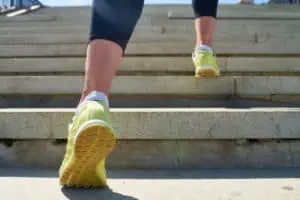
Medical Review By: Luke Maj, MD, MHA
Varicose veins aren’t pretty, and they can ache and itch. Unfortunately, if they run in your family, there’s probably no way to prevent them entirely, but you can take steps — literally and figuratively — to keep your legs looking smoother for longer
“Some risk factors for varicose veins are beyond a person’s control, such as genetics,” said Luke Maj, MD, MHA, an interventional radiologist at the Vein Center at Water’s Edge Dermatology. “But there are many lifestyle changes people can make to reduce the likelihood of developing them.”
To understand how to prevent varicose veins, it’s helpful to know how they form. Veins, which carry blood to the heart, contain tiny valves that clamp shut after each pump of blood to prevent the blood from moving backward. If valves in the leg veins become weak, blood begins to pool in the legs. The increased pressure on the veins makes them enlarge and appear rope-like.
Normal wear and tear makes varicose veins more likely with age, according to Dr. Maj. “You’re also more prone to them if you have a family history of varicose veins. In this case, you may develop varicose veins at a younger age.”
Varicose veins are more common in women, possibly due in part to fluctuations in levels of female hormones that relax the vein walls. The use of oral contraceptives might also increase the risk. Pregnancy makes varicose veins more likely, with each pregnancy adding additional risk.
11 Tips to Prevent Varicose Veins
To keep your veins as healthy as possible in hopes of staving off varicose veins, follow these tips.
1. Avoid standing or sitting for long periods of time.
People who work on their feet, such as cashiers and police officers, or on their backsides, such as office workers and drivers, are vulnerable to varicose veins. If you have to sit or stand for hours, aim to walk for 10 minutes every hour. If you must stand for a long period, periodically leaning against a wall or railing will take some pressure off your leg veins, Dr. Maj said.
2. Perform simple exercises in place.
When you can’t take walking breaks, do exercises every hour to boost the circulation in your legs. While sitting, make circles with your toes and point and flex your feet. While standing, do a few calf lifts. “When you contract your calf muscles, the veins in your legs get squeezed, which helps transport blood back to the heart,” Dr. Maj said.
3. Exercise regularly.
“Any activity that involves the ankle and constricts the calf muscle is good, such as walking, jogging or cycling,” Dr. Maj said. “Exercise also builds muscle in your legs, which helps return blood to the heart.”
4. Lose weight if you need to.
Being overweight puts extra pressure on veins and their valves.
5. Embrace compression wear.
If you stand or sit a lot, Dr. Maj recommends wearing compression sleeves on your legs during the day. They extend from the ankle to just below the knee and gently squeeze the legs to prevent blood from pooling. “I usually recommend sleeves because they’re more comfortable than compression socks or stockings, which cause pressure in the feet,” he said. “But if you have foot or ankle swelling, compression socks or stockings are a better choice.” Ask your doctor what strength of compression wear you need. Dr. Maj often recommends 20-30 mm Hg, which he says is enough compression to be beneficial but not so much that it makes you uncomfortable.
6. Elevate your legs.
Three or four times a day, sit or lie down with your legs raised at the level of your heart or higher for 15 minutes. This helps prevent blood from pooling and can ease leg swelling.
7. Wear shoes that let your ankles move.
“Any style that prevents ankle motion can raise your risk of varicose veins,” Dr. Maj said. This includes high heels and shoes with a very rigid sole, such as platform shoes and wooden clogs.
8. Eat less salt and more potassium.
Reducing salt is a smart move because too much can lead to water retention, which puts pressure on the veins. You can help prevent water retention by consuming foods rich in potassium, such as apricots, lentils, potatoes, and bananas.
9. If you smoke cigarettes, quit.
Cigarette smoking is a major risk factor for varicose veins, according to Dr. Maj. Over time, the chemicals in cigarettes damage veins, which limits blood flow and makes it harder for blood to return to the heart.
10. Avoid falling asleep sitting up.
If you tend to sink into an easy chair in the evening and end up snoozing there all night, it’s time to break the habit. “Sleeping in a chair for hours means blood will pool in your leg veins for hours,” Dr. Maj said. Lying flat in bed keeps your heart and legs on the same level.
11. If you’re pregnant, sleep on your left side.
A growing fetus contributes to varicose veins because it puts pressure on the inferior vena cava, a vein that runs along the right side of the body. Sleeping on your left side relieves this pressure. Varicose veins caused by pregnancy often go away on their own beginning three to 12 months after giving birth.
Article Written By: Jessica Brown, a health and science writer/editor based in Brooklyn, New York. She has written for Prevention magazine, jnj.com, BCRF.org, and many other outlets.





